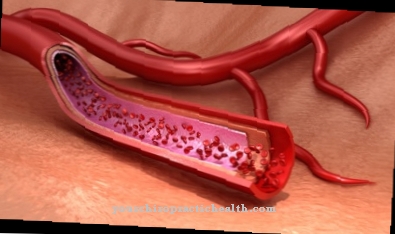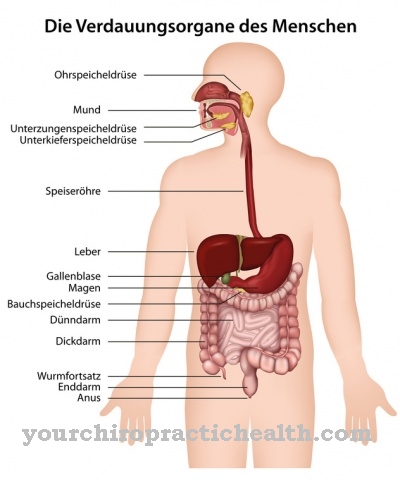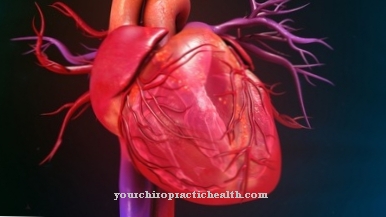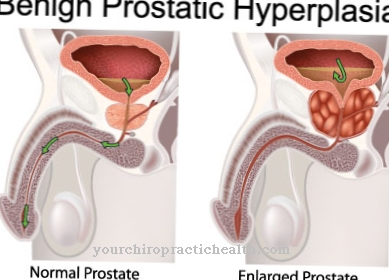The Flexion is one of the main movements of the human musculoskeletal system. It occurs on the spine and many limb joints.
What is the inflection?

Like many anatomical terms, the term flexion comes from Latin and describes the flexion in individual joints or joint chains. The definition takes place with the help of an analytical system, which describes movements based on their sequence in an imaginary body plane and around an imaginary axis. The flexion and the countermovement, the extension, take place in the so-called sagittal plane, around an axis of rotation that runs transversely to the body and through the joint heads.
In most cases, flexion is characterized by the fact that the bones involved approach each other in the course of the movement, which means that the angle is reduced.
Except in the spine, there is flexion in almost all limb joints. In the arm, it occurs in the shoulder, elbow and wrist, as well as in the finger joints. The situation is similar in the leg. There is flexion in the hip, knee and ankle joints, as well as in the toe joints.
The description based on the above example is not always clear. In order to achieve more clarity, additions were added to the names in the wrist and ankle joint, which define the direction of movement. On the foot one speaks of plantar flexion, on the hand of palmar flexion.
Function & task
Flexion is involved in many functional movement sequences that are important for everyday, professional and sporting activities. In the shoulder joint, it is an important component when lifting the arm, especially forwards and upwards. This includes the backward movements in many sports as well as lifting and holding when working overhead.
The flexion in the elbow is an important function when lifting heavy loads or bringing food and drink to your mouth. During the closing of the fist, strong muscular flexion occurs in the hand, in which all flexors are required.
While walking, all joints that have a function of flexion are involved in the swing leg phase. The thigh is pulled forward and up in the hip joint and the lower leg in the knee joint back and up. The faster these movements are performed, for example when sprinting, the greater the range of motion in both joints.
Especially at the beginning of the lifting of the foot when running and walking, the ankles are also challenged. The ankle is actively pressed into plantar flexion, which lifts the heel. The flexing activity of the toe flexors then ensures that the entire foot releases from the ground. Basically, the toes have the same functional capabilities as the fingers, they are only stunted in most people because their flexion function is no longer used as actively. Gripping, holding and guiding objects with your toes is possible with training.
The flexion of the spine is always required when we bend down forwards, for example to pick up something or to work in a stooped position. The total movement results from a summation of the individual components. A small flexion movement takes place in each vertebral joint and all of them added together then result in the entire range of motion.
Flexion is also involved in many sporting activities. In gymnastics or high diving, for example, doing somersaults, in martial arts with skillful rolling, in volleyball and handball during and after hitting or throwing the ball.
You can find your medication here
➔ Medicines for muscle painIllnesses & ailments
Like all movements of the human body, flexion can also be negatively influenced by two fundamental factors. Either the executing muscles are weakened or fail due to injuries or illnesses, or the range of motion is impaired as a result of increased resistance in the connective tissue.
Typical injuries that lead to reduced muscle activity and thus less flexion are strains, muscle fiber tears and muscle tears, but also broken bones. To protect the source of the injury and to avoid pain, the body switches down the muscle activity and the movement is no longer carried out or only to a small extent.
If, for whatever reason, the possible areas of movement are no longer exhausted over a long period of time, connective tissue structures in and around the muscle stick together and restrict mobility and flexion. Typical processes that can trigger processes of this kind are immobilization of a bone using plaster of paris or other measures, but also degenerative changes such as osteoarthritis.
In the spine, herniated discs that exert pressure on the exiting nerves often lead to temporary paralysis, known as lumbago. No movements are possible in this phase, and flexion is also blocked.
If the executing muscles, the flexors, are not supplied with nerve impulses, they can no longer work and the associated movement cannot be performed. This often happens as a result of illnesses and injuries in which the supplying nerves are damaged. The result is complete or incomplete paralysis of the associated muscles. A typical mechanism of injury is paraplegia, in which the spinal cord is severed. All muscles below the supply area fail.
Many neurological diseases result in an impairment of muscle function and thus the ability to move. One example is amyotrophic lateral sclerosis, a serious but fortunately rare disease that continuously paralyzes all of the skeletal muscles. As the disease progresses, the affected people can no longer perform any movements, neither flexion nor extension nor anything else.




























